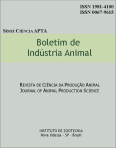Carcass and meat traits of Morada Nova, Santa Ines and ½ Ile de France ½ Texel lambs finished in feedlot
DOI:
https://doi.org/10.17523/bia.v71n3p217Keywords:
finishing, color, meat cuts, tenderness, sheepAbstract
The aim of this study was to evaluate the carcass and meat traits of Morada Nova, Santa Ines and ½ Ile de France ½ Texel lambs finished in feedlot. Weight and proportion of meatcuts, measures of carcass size and color, tenderness, cooking loss and ultimate pH of meat from 10 Morada Nova, 6 Santa Ines and 10 ½ Ile de France ½ Texel were evaluated. The lambs were finished in collective pens, fed ad libitum with 50% corn silage and 50% concentrate and slaughtered at about six months old. Analysis of variance was performed by the procedure PROC GLM of SAS (SAS Inst., Inc., Cary, NC) and means were compared by Tukey test at 5% significance. The Morada Nova lambs had values of 14.1 kg, 13.9 kg, 0.240 kg/cm, 56.2 cm and 35.8 cm for hot and cold carcass weight, compactness index, hip and leg circumference respectively and these values were lower (P <0.05) to values observed in Santa Ines (19.4 kg, 18.8 kg, 0.283 cm/kg, 64.6 cm and 40.0 cm) and in ½ Ile de France ½ Texel (18.6 kg, 18.2 kg, 0.305 cm/kg; 65.4 cm and 41.6 cm) lambs. The hot and cold carcass yield did not differ (P> 0.05) among genetic groups. The scores for conformation and fat cover were higher (P <0.05) in ½ Ile de France ½ Texel lambs (2.4 and 3.0) and the carcass length was greater in Santa Ines lambs (66.3 cm). The ½ Ile de France ½ Texel lambs had smaller (P<0.05) proportion of neck and greater of leg (9.10% and 33.1%) compared to Morada Nova lambs (10.3% and 30.4%) and Santa Inês (10.9% and 31.6%). The weight of shoulder, leg, rack, ribs and flank was lower (P<0.05) in Morada Nova (1.306, 2.127 kg, 0.999 kg, 0.775 kg and 0.433 kg respectively) compared to Santa Inês (1.820 kg, 2.972 kg, 1.355 kg, 0.959 and 0.509 kg) and ½ Ile de France ½ Texel (1.791 kg, 3.007 kg, 1.212 kg, 1.016 kg and 0.563 kg). The neck was heavier in Santa Ines (1.038 kg) which differed (P <0.05) from the other genetic groups (0.725 kg for Morada Nova and 0.830 kg for ½ Ile de France x ½ Texel lambs). The ½ Ile de France ½ Texel lambs showed meat with higher luminosity (37.4) than Morada Nova (33.5) and Santa Ines (31.7) lambs. When slaughtered at six months of age lambs of the genetic groups evaluated result in similar good quality meat, however, Morada Nova lambs have lower weights of carcass and meat cuts as well as smaller carcass than Santa Ines and ½ Ile de France ½ Texel lambs.Downloads
Downloads
Published
Issue
Section
License
Os autores não serão remunerados pela publicação de trabalhos, pois devem abrir mão de seus direitos autorais em favor deste periódico. Por outro lado, os autores ficam autorizados a publicar seus artigos, simultaneamente, em repositórios da instituição de sua origem, desde que citada a fonte da publicação original seja Boletim de Indústria Animal. A revista se reserva o direito de efetuar, nos originais, alterações de ordem normativa, ortográfica e gramatical, com vistas a manter o padrão culto da língua e a credibilidade do veículo. Respeitará, no entanto, o estilo de escrever dos autores. Alterações, correções ou sugestões de ordem conceitual serão encaminhadas aos autores, quando necessário. Nesses casos, os artigos, depois de adequados, deverão ser submetidos a nova apreciação. As opiniões emitidas pelos autores dos artigos são de sua exclusiva responsabilidade. Todo o conteúdo deste periódico, exceto onde está identificado, está licenciado sob a Licença Creative Commons Attribution (CC-BY-NC). A condição BY implica que os licenciados podem copiar, distribuir, exibir e executar a obra e fazer trabalhos derivados com base em que só se dão o autor ou licenciante os créditos na forma especificada por estes. A cláusula NC significa que os licenciados podem copiar, distribuir, exibir e executar a obra e fazer trabalhos derivados com base apenas para fins não comerciais.













